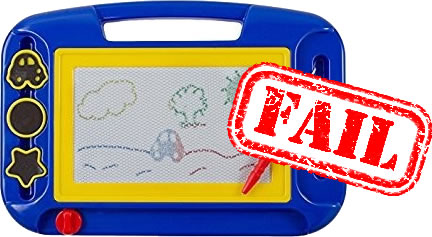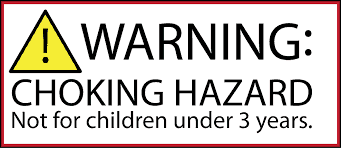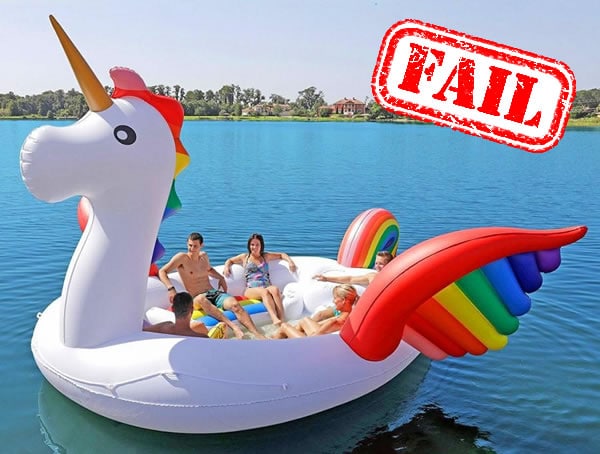This post is by the author of the Garlic Press Seller blog, and is written anonymously to protect their business.
I have been an Amazon FBA seller for three years now. I am a big believer in sharing knowledge, and that you can learn everything you need to start selling online from freely available articles.
Based on that perspective I started my web blog and in this post, I want to tell you about my three biggest FBA fails. Hopefully people can learn from my errors and it might even prevent you from making the same mistakes that I made.
Fail #1: Customs seized my shipment!
This was definitely my biggest loss ever in my FBA career. I lost a whole container load of 5,000 units and had to stop selling two of my best products! This is how it happened.
I used to sell these magnetic drawing boards:

Normally I don’t reveal my products to other FBA sellers. But since I don’t sell this product anymore, I am happy to show you. This was one of the first products I started selling and things were going great.
I started pretty small with only 1,000 units and was increasing the order quantity with every re-order. I even added another variation of this product to my range, and I was feeling good about my FBA business.
My fourth order for these products, for 5,000 units in total, was in progress when my freight forwarder notified me that there was a delay. After a bit of research, I figured this could be a normal routine check and that it was nothing to worry about. That was until I received the following email from US customs:
Dear XXX,
I am a Compliance Officer with the US Consumer Product Safety Commission (CPSC). I am contacting you in regards to entry number XXX which entered the port of XXXX, WA on XXX. The Importer of Record is listed as XXX and the Ultimate Consignee is listed as X. Your name was provided to CPSC staff by your Importer Broker, XXX.
CPSC staff collected samples on XXX to determine compliance with CPSC’s mandatory standards for children’s products. A CPSC sample number was assigned to the following products:
- CPSC sample number XXX
- CPSC sample number XXX
CPSC staff has evaluated the products and age graded them for under three years of age (19 – 35 months). This means the products meet the requirements for small parts testing. As the product is received, the magnet attachments qualify for the definition of small parts, and therefore the products are in violation of small parts for children’s products under the age of three. In addition, after use and abuse testing, small parts of plastic break off which also qualify for the definition of small parts. The test reports are attached for you to review. More information on small parts and the requirements may be found at the CPSC.
Due to the violations outlined above, CPSC staff requests that you forfeit the products that were sampled to Customs Border and Patrol (CBP) and agree to seizure. Were these items previously imported?
They were seizing all my products! The problem was that I was selling a product with small parts. If you are selling a product with small parts you are not allowed to target small kids under three years, and you should have this sticker on your packaging:

I had that sticker, but I made the mistake of having a small kid on my packaging that was clearly younger than three years. Because of this, US customs thought I was targeting kids under three years and they seized my whole shipment!
Fail #2: Getting screwed by my supplier
Ordering from China can be very intimidating. I was definitely hesitant when ordering from China for the first time. I was handing over a huge sum of money to someone I had never met, hoping they would manufacture the product I wanted. There are so many things that could go wrong, but I had to learn the hard way.
Not too long ago I had a successful launch for one of my products. I started with 1,000 units for the first order. But it was a huge hit and soon I realized I needed to re-order because I would run out of stock in about 4 months. The product already had around 15 reviews with a 4.6 average, so I had a good feeling about this product and was confident enough to order 3000 units for the second order. Of course, since I was doing a larger volume I wanted a better price.
After a bit of negotiating, I was able to get the price down from $2.67 to $2.19 per unit. Everything looked perfect. My product was a hit and I was able to save $1440 by driving a hard bargain.
Now the real horror starts when this second batch hits the FBA warehouse. All of a sudden I started getting loads of bad reviews and returns. Most customers mentioned the product was very flimsy, but I had never seen this complaint with the first batch. So I decided to ship twenty units to my house to confirm what I was now suspecting:
- The second batch was made out of thinner plastic.
- From the twenty products, 11 were missing parts.
My supplier had screwed me.
Because of this, my review rating dropped to a three-star average, sales slowed dramatically and it took me forever to sell the remaining 3,000 units at break-even. This pretty much killed my successful product.
I believe the supplier used a cheaper material and saved as much as he could on production. Maybe he did this because I negotiated a lower price, or he was planning to do it all along. The thing is, he got away with it because I never inspected the goods.
My key takeaway from this fail: ALWAYS inspect your goods before paying 70% to your supplier!
Fail #3: Wrong product selection
This is probably the most common failure and loads of FBA sellers will make this mistake. In my opinion, product selection is the most important part of your FBA business. It doesn’t really matter how good you are at marketing, PPC or other aspects – if you pick the wrong product, you will fail.
I have these requirements that I use when doing my product research:
- $15 + sale price
- High demand: At least $3,000 revenue per month for competitors in my niche.
- Healthy profit margin: Profit margin should be at least 33% of the sales price, so I can make at least $1,000 per month on this product.
- Easy to manufacture
- Weak competition: The competition should have around 50 reviews or less.
From my experience, you will have the biggest chance of your product becoming a success if you stick to these requirements, especially as a new seller.
After selling for about 2 years, I was feeling confident and thought that I could move away from these requirements. I found a product that ticked all the boxes except one: it was definitely not easy to manufacture!
It was an inflatable pool toy. And after reading the negative reviews of my competitors, I found out it was notoriously difficult to manufacture a pool toy that won’t break after a couple of uses.

Despite this, I still decided to go through with this product. I figured I had enough experience ordering from China and having inspections done, that I was ready to order a “hard to manufacture product”. Well, it turns out that I wasn’t ready.
I went with a premium supplier who offered to use the thickest type of plastic, and had inspections both during production and after production, but I still received a subpar product. Soon after launching, the negative reviews started coming in about how the product would leak air, even after a couple of uses.
So yeah, I learned the hard way that I should stick to my product research requirements and not try to manufacture difficult products. The same can be said about any electronic products, which are also notoriously hard to make!
Fail not!
These were my biggest FBA fails. I hope this was useful, and that I was able to prevent at least one person from making the same mistakes that I made. Check out my blog for more case studies, guides and FBA tool reviews.
Cheers!
This post was by the author of the Garlic Press Seller blog, and was written anonymously to protect their business.

"My key takeaway from this fail: ALWAYS inspect your goods before paying 70% to your supplier!"
How? Should we put down 30% deposit then have someone inspect it before paying the outstanding 70%...?
Also where should the product be inspected, at the suppliers warehouse? At the port if its FOB?
And who do we get to inspect the product? Should we hire a 3rd party company.?